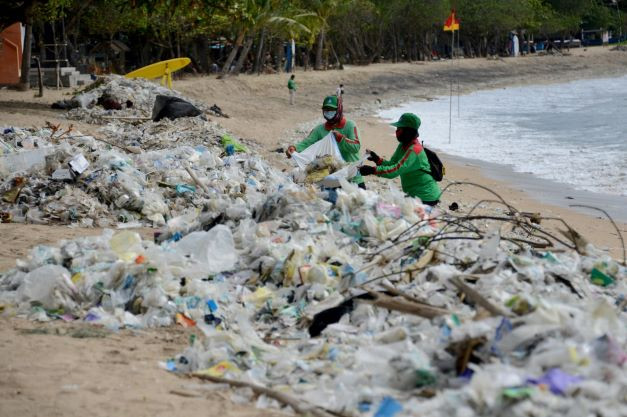Popular Reads
Top Results
Can't find what you're looking for?
View all search resultsPopular Reads
Top Results
Can't find what you're looking for?
View all search resultsHow much plastic are we ingesting?
Measuring microplastics in humans is challenging, but researchers already have preliminary figures.
Change text size
Gift Premium Articles
to Anyone
P
lastic waste is increasingly engulfing everything on the planet, from ecosystems to people, but we don’t have adequate knowledge of its full ill effects. We do not know exactly how many microplastics humans are ingesting daily and what the possible consequences are.
To date, only a few studies have been launched to address these basic questions of human health. This study estimates that globally, on average, humans may take in 0.1-5 gram of microplastics weekly through various pathways.
Commonly, these are through food and drink, inhalation and even dermally, through our skin. These minute particles, less than 5 millimeters, then travel through the human digestive, respiratory and circulatory systems.
Microplastics are often referred to as a “cocktail of contaminants” due to their presence in chemical additives, heavy metals, pharmaceuticals, pesticides and other organic pollutants in the environment.
Microplastics could pose a significant risk to human health in the long run as the contaminants within them have been linked to several human illnesses and diseases including endocrine disorders, cardiovascular and reproductive problems plus obesity, diabetes and cancer.
It is, therefore, pressing that researchers determine the quantity of microplastics being taken in by the human system and its potential impacts.
A definitive global average rate of microplastic ingestion (GARMI) is needed to assist in human health risk assessments and to formulate effective management and policy options.
This preliminary study shows that microplastic particles are potentially ingested through the consumption of water, shellfish, fish, salt, beer, honey and sugar.
Globally, humans potentially ingest between 11,845 and 193,200 microplastics per person per year ranging between 7.7 g and 287 g per person per year with the largest source being drinking water (both tap water and bottled water).
This estimation of the average rate of microplastic ingestion can form the basis of a human health risk evaluation.
Apart from food and drink, studies that probed the inhalation of microplastics via aerosols and household dust showed a high risk to humans with lungs potentially exposed to an additional 26–130 microplastic particles every day.
Generally, higher counts of microplastics were reported in bottled water, and this is likely due to its packaging and processing. Raw or untreated water is not included in studies as it is more challenging to identify and quantify the finer plastic particles.
Curiously, the amount of microplastics found in raw water samples to date was the same as those obtained for bottled water.
Identifying and quantifying fine microplastics (less than 1mm) is a key challenge facing researchers and the field is still new. Currently, Raman spectroscopy and Fourier-transform infrared spectroscopy (FTIR) are used but they are not perfect.
For instance, the intensity of the laser in these instruments could damage the microplastics being studied and measured.
Contaminants in microplastics have been linked to serious health outcomes.
Interestingly, an experimental study revealed that the size of a microplastic particle influenced its ingestion rate. This more than its shape, which suggests research focusing more on size is needed.
Who is at more risk of consuming microplastics? An individual's vulnerability to ingestion of microplastics will influence their level of exposure.
For example, those with significant consumption of shellfish and bottled water and with a high calorie intake will be more likely to have increased exposure compared to those who consume less.
Individuals who often consume plastic-packaged food and drink, meanwhile, will have higher exposure as microplastics in consumables is a direct result of plastic packaging.
It is also possible that people from regions with low dependence on plastic products, better waste management facilities, quality water sources and good policies with respect to food health and safety will be at less risk to microplastic exposure compared to those from places still developing in these areas.
Further research is necessary to confirm this. Nonetheless, there is enough evidence to indicate these variables influence people's exposure and the global average rate of microplastic ingestion.
There are a number of hurdles for scientists when measuring the average rate of microplastic ingestion due to insufficient data, differences in identification techniques, analytical challenges, disparate reporting metrics and uncertainties as well as varied experimental conditions.
The uncertainty level goes up with every assumption and extrapolation. This situation can only be reduced with more research.
Recommendations for future directions include standardizing analytical methods and parameters for microplastics collected during studies (e.g. size, shape, polymer, number of particles, mass of particles).
To determine the negative health impacts, studies on the influence of variables on the global average rate of microplastic ingestion must also be done.
More detailed data from other food groups consumed daily – oils, meat, pasta, bread, corn, wheat, rice, milk, etc. – need to be collated.
Also to be further probed is the toxicity of microplastics ingested in terms of size, mass, polymer and shape and determining the extent microplastics travel from cooking and eating utensils (especially by children) and food packaging into food.
The worldwide presence and pervasiveness of microplastics are accepted facts. However, the amounts of microplastics humans ingest are yet to be fully defined. Still, early data indicates that a cautionary approach is embraced now to avoid a future crisis.
---
The writer is associate professor at the School of Engineering of the University of Newcastle, Australia. This article is republished under a Creative Commons license.











